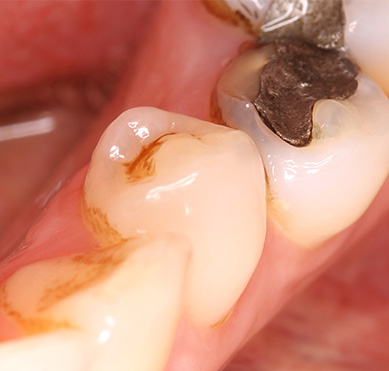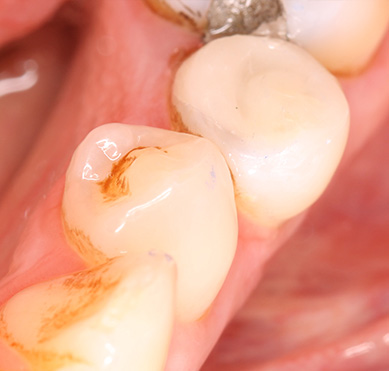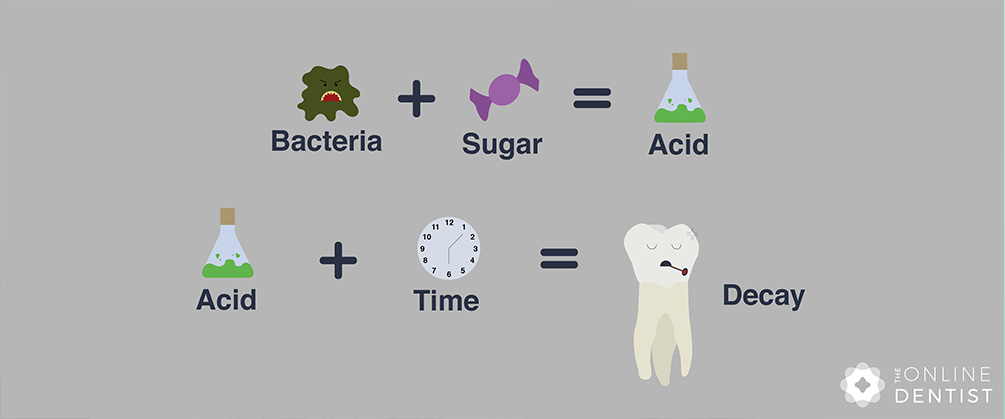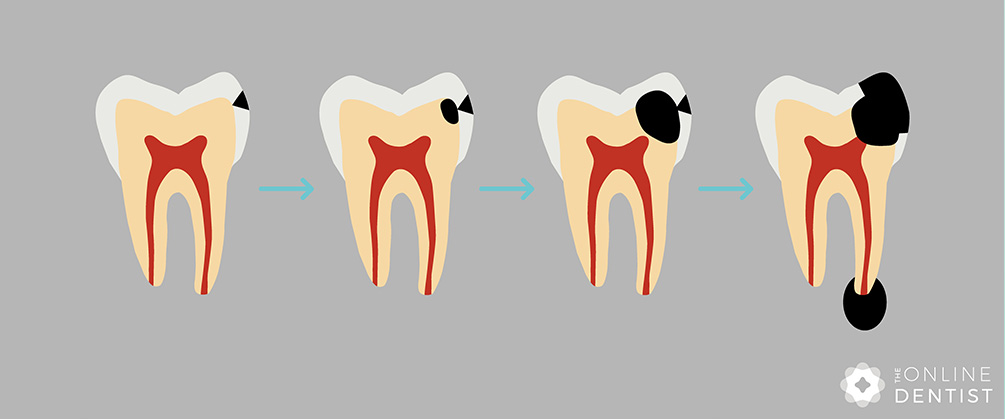Tooth decay is when you get holes (also known as cavities) in your teeth. This is caused by bacteria in plaque. It’s one of the main reasons why you need to keep your mouth clean.
We all naturally have bacteria in our mouths. If bacteria are left on your teeth, they will eat sugar from your food that comes through your mouth on its way to your stomach. The bacteria will digest this sugar and turn it into acid. This acid is then left on your tooth surface by the bacteria. It is this acid that damages the tooth and, given time, will cause a hole or cavity to form.
Some simple maths
Bacteria + Sugar = Acid
Acid + Time = Decay
If the bugs can make a little break in the enamel, decay can then start in the dentine on the inside of your tooth. The enamel on the outside is really strong and won’t break down so you often won’t be able to see the hole. But the dentine on the inside of your tooth is much less tough and the hole can grow rapidly. The first thing that you or your dentist may see is a grey or brownish shadow under the enamel. However, you may not be able to see anything as the decay grows and grows.
Left to grow, this hole may irritate or damage the nerve that lives in your tooth. If this happens, you may feel the tooth becoming painful. To start with, it might be temperature or sweet stuff that makes the tooth hurt. If the pain starts to hang around for a long time or starts on it’s own then this needs immediate attention. Take a look at the toothache article for information on different symptoms.
If the enamel above the hole breaks down, you will then be able to see the cavity and feel the sharp edges left. Decay is a simple problem to solve but it does need treating before it becomes painful. When the tooth is getting painful, often simple treatments will not work and something more tricky is required if you want to save the tooth.
This is why it is important to have regular checks with your dentist. Regular checks mean that you catch decay early. If you leave a tooth until it is painful, you risk losing the tooth. You may have no idea that there is a hole until it’s too late.
What’s the treatment; Filling
A filling does exactly what it sounds like. We scoop out all of the bugs and rotten tooth and then we fill the hole left in the tooth. Usually, this will require the tooth to be numbed so that it is comfortable to remove all the nasty stuff. It’s a very simple thing to do and the idea is to stop the hole getting bigger so that you can save as much of the tooth as possible.
There are lots of different materials available to fill a cavity but the two main options are a metal filling or a tooth coloured filling.

Amalgam filling
Metal fillings
Metal fillings are made of a material called amalgam. It is mainly made of silver but it does also have mercury in it. Amalgam gets a lot of bad press because of the mercury content but there is no solid, scientific evidence that it causes side effects in people that have them.
Lots of patients ask to have all of their amalgam fillings removed for health reasons. Something that is very important for patients to be aware of when asking to have their fillings replaced is that drilling out the amalgam releases a lot more mercury than just leaving them there. So if this is something you want to have done, it is something that the dentist must do very carefully.

Tooth coloured filling
Tooth coloured fillings
Whatever the arguments about the health impact of metal fillings, we can all agree that they don’t look great. A much nicer and more modern type of filling material is something called composite. This is basically a tooth coloured material which is glued into or onto the tooth. It is used at the front and back of the mouth and looks more like a tooth rather than a bit of silver. This is a fantastic material and recent advancements mean that these tooth coloured fillings are lasting longer and longer.
Benefits and Risks
The benefit of having a filling is that the decay is removed and stopped.
The risk with a deep filling is that the tooth can become painful and need more treatment. I wouldn’t blame this on the filling though. The pain has ultimately been caused by the bacteria that made the hole in the first place. The filling was necessary to stop the hole getting bigger. If a tooth is painful after you’ve had a filling, the chances are that the tooth was about to become painful anyway.
The consequences if the decay is not treated is that the hole could get bigger and bigger, leading to the tooth breaking down and you losing the tooth.
Sometimes a cavity is so big that the nerve in the tooth is damaged. In this situation, a filling will not be successful. What if a filling isn’t enough?
Keep updated with the Online Dentist newslettersign up today
Recent Articles
 Tooth decay is when you get holes (also known as cavities) in your teeth. This is caused by bacteria in plaque. It’s one of the main reasons why you need...
Tooth decay is when you get holes (also known as cavities) in your teeth. This is caused by bacteria in plaque. It’s one of the main reasons why you need...
 NB: If you come to this section in a rush because someone has knocked an adult tooth completely out, go to ‘Knocked out adult tooth’ article. Of course young children...
NB: If you come to this section in a rush because someone has knocked an adult tooth completely out, go to ‘Knocked out adult tooth’ article. Of course young children...






